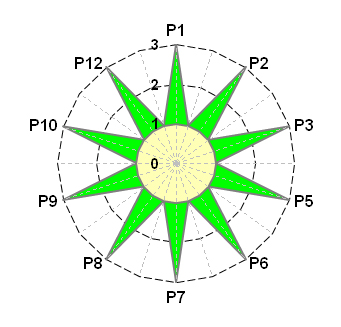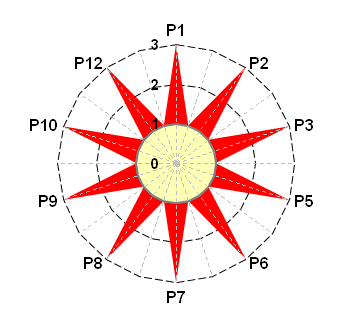Green Star construction
The metric Green Star was designed to consider simultaneously all of the Principles of Green Chemistry applicable in each situation (a reaction, or a synthetic pathway, or a chemical process, etc.) when pursuing greenness and to provide a holistic assessment that is intended to be a systemic metric of the inherent benignness of the procedure.
In the construction of Green Star, for each intervening substance, information about hazards to human health and the environment, potential chemical accidents (health and physical hazards are considered in this case), as well as renewability and tendency to break down into innocuous degradation products, are collected. This information may be obtained from safety data sheets (SDS). SDS may be obtained in WEB for example from Sigma-Aldrich and Merck Chemicals.
The Globally Harmonized System of Classification and Labelling of Chemicals (GHS) is used in the classification of hazards. GHS regulation classifies substances and mixtures according to their physical, health and environmental intrinsic hazards. For each of these, hazard classes are established which define the nature of the hazard. Each hazard class is divided in several hazard categories according to the severity. To each hazard class and category are assigned hazard statements used to characterize the hazards (phrases that describe the nature and degree of the hazard). Hazard statements are represented by hazard codes, composed by a letter H and a number beginning with a figure indicating the hazard type (2 for physical, 3 for health, and 4 for environment hazards) followed by two figures, corresponding to sequential numbering of hazards inside the class. Hazard symbols (pictograms−graphic elements intended to succinctly convey information) and signal words (a word, danger or warning, which indicates the relative level of severity of the hazards) are also defined. Precautionary statements may be also assigned to the substances. These are phrases that describe recommended measures that should be taken to minimize or prevent adverse effects (resulting from exposures, improper handling, or storage) caused by hazardous substances or mixtures. For more information see here.
Hazards are scored from 1 (low hazard) to 3 (high hazard). See the criteria here. Using predefined criteria, a score is attributed to the accomplishment of each of the Principles of Green Chemistry (on a scale from 1 to 3, minimum to maximum value of perceived greenness).
The set of values is represented graphically by a star in an Excel spreadsheet in which each dimension of the graphic describes a principle. The number of dimensions of the chart is the number of principles used in the greenness evaluation, which may be less than twelve if some of the Principles of Green Chemistry are not relevant.
The Green Star charts have only ten corners in teaching experiments, as the fourth and eleventh principles were not aplicable, because teaching experiments do not include the preparation of new products.
In the case of experiments that do not involve syntheses, the number of principles assessed is reduced to six. Automatic models to construct the green stars may be uploaded in the next links
Model to construct green star when 10 principles apply
Model to construct green star when 6 principles apply
As the score length represented in each dimension of the plot is the degree of accomplishment of the corresponding principle, the area of the chart is a visual holistic metric of greenness. Thus the chart is the Green Star: the larger its area, the greener is the reaction, synthetic pathway, etc.
The Green Star Area Index varies from 0% (no greenness at all, Fig. 1b) to 100% (maximum greenness, full star, Fig. 1a).


GSAI = 100 GSAI = 0
Figura 1a. Green star of maximum greenness Figura 1b. Green star of minimum greenness
Often synthesis procedures used in school laboratories involve two stages (“stage” is a series of successive operations to yield an isolated product12) and three steps (reaction, isolation, and purification), as shown in Figure 2. The first stage includes the reaction (R) and the isolation (I) steps, and the second is the step for purification (Pu) of the product. Figure 2 includes the types of materials used in each step, showing an uneven distribution between the reaction and the workup. The greenness of the global process (G) is influenced differently by each of the three steps.

Figure 2. Graphical representation of the model used to define the steps and stages of a synthesis and reagents involved in each; A,B stoichiometric reagents; P product; C byproducts.
The evaluation of greenness may consider separately the three steps, reaction, isolation and purification of the product as well as the global process. The steps of isolation and purification of the product generally involve no reaction, only physical operations, and therefore, principles P2 (atom economy), P3 (less hazardous chemical synthesis), P8 (reduce derivatives), and P9 (preference for catalysts) are also not applicable - only six principles are assessed.
